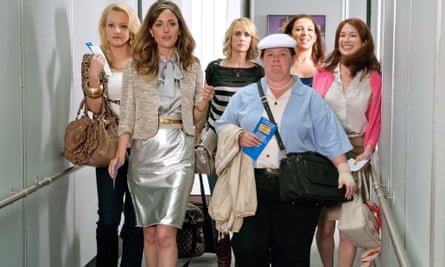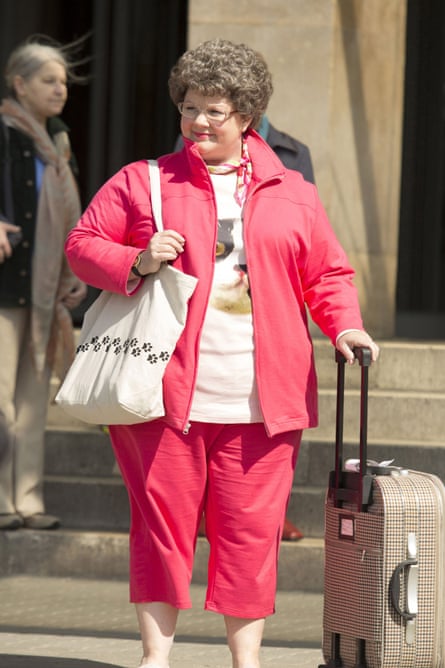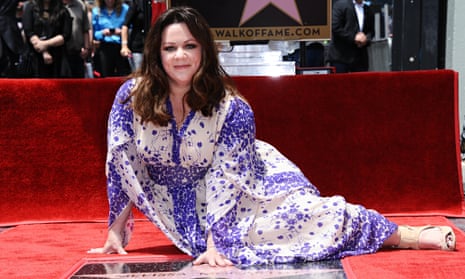The latest Forbes list of the world’s highest-paid movie stars proves that old-fashioned sexism is alive and well in the film industry from Hollywood to Bollywood: why else would there be almost $30m separating the top male earner, Robert Downey Jr, who pockets $80m per movie, from his female equivalent, Jennifer Lawrence ($52m)? But anyone who prefers to see the glass of Dom Pérignon as half-full need only look to third place in the list of most highly paid actresses. For here, behind Lawrence and Scarlett Johansson ($35m) is 44-year-old Melissa McCarthy, a performer as different as could be imagined from the others in the upper reaches of the Forbes rankings.
Admittedly, her $23m fee only puts her equal with Hugh Jackman, 21st on the male list. McCarthy’s placement, though, is significant for more than just its monetary value. As a middle-aged woman who would be considered large by Hollywood standards (though unremarkable in those areas of life not policed by body fascists), she is a corrective to the images of women that saturate the media. She also happens to be a skilful and joyous comic talent.
Until five years ago McCarthy, born and raised in Plainfield, Illinois, was gainfully employed but not much noticed. She was a regular for seven years on the US television series Gilmore Girls and had notched up 20 or so minor film and TV parts. Everything began to change in 2011, when she was cast as one half of a couple who meet at Overeaters Anonymous in the sitcom Mike & Molly. Lucy Mangan in the Guardian commended McCarthy and her co-star Billy Gardell on some “unfeasibly delicate and charming work”, while decrying the show itself for hanging every one of its gags on the subject of their weight. (A sixth series was recently commissioned.)
McCarthy’s own success quickly overtook the series when she was cast as part of the 2011 ensemble comedy Bridesmaids. That film’s director, Paul Feig, has likened her audition to “a religious moment” for him. “It actually took me 30 seconds to realise it was even funny,” he said. “She made the decision to play the character kind of guy-ish, like, ‘We’re gonna go out and make a man sandwich’.”
The choice was pivotal not only to the movie but also to McCarthy’s persona. Where Mike & Molly had put weight at the centre of the comedy, McCarthy’s performance as Megan in Bridesmaids bulldozed through the subject. Megan’s cheerful obliviousness to how she is received by those around her is a lesson not merely in comic abandon, but in the euphoria of freeing oneself from the judgment of others. From her first scene, where she scans an engagement party ravenously for available men, rejection simply never occurs to her. To its credit, the film never laughs at her: the joke is in her confidence and how it overpowers those around her. If Megan wants something, she puts in old-fashioned elbow-grease to get it. “It was a great part,” McCarthy said. “I didn’t wear any makeup. I communicated telepathically with dolphins.”

The Oscar and Bafta nominations she received for her performance were not the most significant benefits of making Bridesmaids. One was cementing a creative partnership with Feig, who has now directed her in two other films, The Heat and the recent comic thriller Spy. (They are currently at work on their latest: a female-led reboot of Ghostbusters, also starring Kristen Wiig of Bridesmaids.)
Another was creating a persona that has underpinned most of her subsequent work. Megan had no inhibitions, partly because McCarthy had Feig behind the camera egging her on in her wild improvisations. “When it works, it works like jazz,” he said. “I can’t get enough of it. Sometimes she’ll go to say something terrible and then she’ll stop and she’ll say, ‘I can’t say that.’ I say, ‘You have to, because whatever comes out of your mouth, I know it’s going to be the finest goddamn thing’.”
All her characters since have had at least a shred of that shamelessness – it’s one of the qualities that audiences crave in her, the equivalent of Tom Cruise’s smile or Jennifer Lawrence’s sassiness. It’s there in the brilliant odd-couple comedy The Heat, where she provides a shambolic contrast to her prim co-star Sandra Bullock. And you can see it too in Identity Thief. That film was not much liked by critics, but it remains interesting in pushing the sexual aspect of her persona as far as possible. Even more so than in Bridesmaids, McCarthy plays sexual rapaciousness dead straight. There is no sense our guffaws are a response to the absurdity of her desire. Once again, it is the embarrassment it causes others, and McCarthy’s lack of concern at this, that allows the comedy to bloom.
Not everyone is convinced that the joke isn’t on McCarthy. On the website Dame, Laura Bogart complained of the actress’s “rough-hewn and unfeminine characters” and insisted that the running joke in Bridesmaids was that “fat women’s bodies are inherently disgusting, especially when displaying sexual desire, and courting desire in turn”.
Quite apart from overlooking the fact that Megan gets her man in Bridesmaids, and is unarguably happier and more fulfilled than any of her more conventionally attractive or glamorous friends, this also ignores McCarthy’s skill as a physical comedian. It is unfair to object, as Bogart does, to the scene in Tammy in which the actress gets laughs from having her “broad body splayed against the windshield”. What is she supposed to do – hide behind the windscreen wiper? She can hardly act with any other body than her own. Under these restrictions, radio comedy would be her only option.
And don’t forget she co-wrote Tammy with her husband, the actor Ben Falcone, who also directed it. Actresses who can shape their own star vehicles and get them green-lit, rather than submit to the demands of male producers and executives, are few and far between. She has also launched her own clothing line, Seven7, catering for women of all sizes, which was prompted when she couldn’t find a designer who was able to supply her with clothes to attend the Oscars.
She is rightly blasé about her body. (“My weight? It is what it is,” she has said.) References to her as “America’s plus-size sweetheart” have been received by the actress with understandable annoyance: “It’s like I’m managing to achieve all this success in spite of my affliction.”

It’s disgraceful that she has had to put up with sizeist insults from the press: the US film writer Rex Reed called her “tractor-sized” and likened her to a hippo in his review of Identity Thief; she confronted another journalist who had complained that she looked unattractive in Tammy and told him to make sure he didn’t talk like that to his daughter. “It’s an intense sickness,” she has said of society’s attitude towards women. “For someone who has two daughters, I’m wildly aware of how deep that rabbit hole goes. But I just don’t want to start listening to that stuff. I’m trying to take away the double-standard of ‘You’re an unattractive bitch because your character was not skipping along in high heels’.”
The Forbes ranking is a good riposte, but it really only ratifies what we already know about her. Good acting doesn’t need validation – the Oscar nominations and the eight-figure pay-packets count for nothing in the end. What’s valuable about McCarthy’s work is its quality: the nuttiness of her characterisations, the depth of her empathy, the precision of her timing. These are the things that make the prospect of Ghostbusters (released next summer) or her upcoming collaboration with Falcone, Michelle Darnell, so tantalising.
It is only because of the warped priorities and damaged body-image prevalent in society that her placing on the Forbes list has accrued any significance. The cheerleaders of self-loathing would have it that nothing tastes as good as skinny feels. The levels of happiness and fulfilment apparent in McCarthy, not to mention the pleasure she brings to cinemagoers, look more inspiring than worrying about whether people you don’t even know think your bum looks big in this.
QUEEN OF COMEDY
Age 44
Home Born in Plainfield, Illinois
Family Married to Ben Falcone, two children
Acting career Started out working as a stand-up comedian before a breakthrough role playing Sookie St James in Gilmore Girls, which ran from 2000-2007. Later starred in the comedy series Samantha Who? and as Molly in the CBS sitcom Mike & Molly. In 2011, she played the part of Megan in the box-office hit Bridesmaids. Since then, McCarthy has starred in This is 40 (2012) Identity Thief (2013), The Heat (2013), St Vincent (2014), Spy (2015) and Tammy (2014), which she co-wrote with her husband Falcone.
Fashion Created women’s clothing line Melissa McCarthy Seven7

Comments (…)
Sign in or create your Guardian account to join the discussion